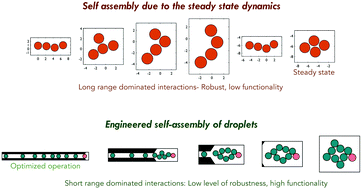On the role of hydrodynamic interactions in the engineered-assembly of droplet ensembles†
Abstract
Droplets, as they flow inside a microchannel, interact hydrodynamically to result in spatio-temporal patterns. The nature of the interaction decides the type of collective behaviour observed. In this context, we study the application of droplet microfluidics in the area of complex-shape particle synthesis. We show how the dynamics of droplet motion, the steady-state characteristics, the short and long-range hydrodynamics, the dependence on inlet conditions etc. are all related to the features that characterize a device like the functionality (producing many shapes) and robustness (insensitivity to fluctuations). Two primary operating regimes are identified, one where long-range interactions are dominant and the other where they are short-range. In the former, the shapes formed by droplets are steady-state solutions to the governing equations, while in the latter they are a function of how the droplets enter the channel (frequency of entry). We show that identifying the inlet conditions for producing a particle of the desired shape requires the use of a systematic approach to design which involves solving an optimization problem (using genetic algorithms) to identify the optimal operating strategy. With the knowledge of the hydrodynamics between the droplets, we demonstrate how one can reduce the complexity of the design process. We also discuss the control strategies required if one were to realize the identified operating strategy experimentally.



 Please wait while we load your content...
Please wait while we load your content...